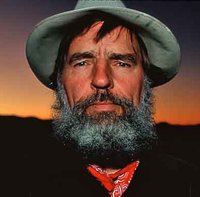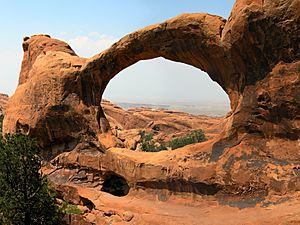Edward Abbey facts for kids
Quick facts for kids
Edward Abbey
|
|
|---|---|
 |
|
| Born | January 29, 1927 Indiana, Pennsylvania, U.S. |
| Died | March 14, 1989 (aged 62) Tucson, Arizona, U.S. |
| Occupation | Essayist, novelist |
| Notable works | Desert Solitaire The Brave Cowboy The Monkey Wrench Gang |
Edward Paul Abbey was an American writer and environmental activist. He was born on January 29, 1927, and died on March 14, 1989. Abbey was known for speaking up for nature and criticizing how public lands were managed. His most famous books include Desert Solitaire and The Monkey Wrench Gang. Desert Solitaire is about his time as a park ranger. The Monkey Wrench Gang inspired many environmentalists.
Contents
Edward Abbey's Early Life and School
Abbey was born in Indiana, Pennsylvania, on January 29, 1927. His mother, Mildred, was a teacher and church organist. She taught him to love classical music and books. His father, Paul, was a farmer with strong beliefs about society and freedom. These ideas greatly influenced Edward.
Abbey finished high school in Indiana, Pennsylvania, in 1945. Before he turned 18, he faced being drafted into the U.S. Military. Instead, he decided to explore the American Southwest. He traveled by walking, bus, hitchhiking, and even riding freight trains. During this trip, he fell in love with the desert lands of the Four Corners area.
In the military, Abbey served two years as a military police officer in Italy. He was promoted twice but also demoted twice for not always following rules. He was honorably discharged as a private. His time in the military made him distrust big organizations. This feeling influenced his writing throughout his career.
When he returned to the United States, Abbey used the G.I. Bill to attend the University of New Mexico. He earned a bachelor's degree in philosophy and English in 1951. He later received a master's degree in philosophy in 1956. While in college, Abbey worked many jobs. He was a newspaper reporter and a bartender.
Abbey married his first wife, Jean Schmechal, while in college. After graduating, they traveled to Edinburgh, Scotland. Abbey studied for a year at Edinburgh University. During this time, he and Jean separated and later divorced. In 1952, Abbey married his second wife, artist Rita Deanin. They had two sons, Joshua and Aaron.
Abbey's master's thesis looked at anarchism and the morality of violence. He explored why anarchism is often linked to violence. He also questioned how anarchists justified using violence. After getting his master's degree, Abbey spent a year at Stanford University.
Working as a Park Ranger for National Parks

In 1956 and 1957, Abbey worked as a seasonal park ranger. He worked for the United States National Park Service. His job was at Arches National Monument (now a national park) in Utah. He worked from April to September each year. He kept trails in good shape, greeted visitors, and collected fees. He lived in a trailer provided by the Park Service. He also built a shelter for himself.
While at Arches, Abbey took many notes and made sketches. These later became his first non-fiction book, Desert Solitaire.
In 1961, his second novel, The Brave Cowboy, was made into a movie. The film, called Lonely Are the Brave, starred Kirk Douglas. In 1981, Abbey's third novel, Fire on the Mountain, was also made into a TV movie.
On October 16, 1965, Abbey married Judy Pepper. She worked with him as a park ranger in the Florida Everglades. She also worked as a fire lookout in Lassen Volcanic National Park. Judy died of leukemia on July 11, 1970. This was a very sad event for Abbey. He dedicated his book Black Sun to her.
Desert Solitaire, Abbey's fourth book, was published in 1968. It was his first non-fiction work. In the book, he describes his time in the canyonlands of southeastern Utah.
In 1973, Abbey married his fourth wife, Renee Downing. They divorced four years later.
Edward Abbey's Later Years
Abbey met his fifth and final wife, Clarke Cartwright, in 1978. They married in 1982. They had two children, Rebecca and Benjamin.
In 1984, Abbey returned to the University of Arizona. He taught creative writing and hospitality management courses. During this time, he continued writing his book Fool's Progress.
In July 1987, Abbey attended an Earth First! meeting. He had a strong debate with a group called Alien Nation. This was about his view that America should not allow any more immigration. Abbey wrote about this event in his book Hayduke Lives!.
Death and Burial of Edward Abbey
Abbey died on March 14, 1989, at age 62. He died at his home in Tucson, Arizona. His death was due to problems from surgery. He had bleeding in his esophagus. He left a message for anyone who asked about his last words: "No comment."
Abbey also left instructions for his burial. He wanted his body carried in a pickup truck. He wished to be buried as soon as possible. He did not want to be embalmed or put in a coffin. Instead, he wanted to be placed in an old sleeping bag. He asked his friends to ignore state burial laws. "I want my body to help fertilize the growth of a cactus or cliff rose or sagebrush or tree," he said.
For his funeral, Abbey asked for no formal speeches. He wanted gunfire and bagpipe music. He also wanted a cheerful party with lots of singing, dancing, talking, hollering, and laughing.
Abbey's body was buried in the Cabeza Prieta Desert in Pima County, Arizona. His friends carved a marker on a nearby stone that reads:
EDWARD
PAUL
ABBEY
1927–1989
No Comment
Abbey is survived by his two daughters, Susannah and Rebecca, and three sons, Joshua, Aaron, and Benjamin.
Documentaries About Edward Abbey
- Wrenched (2013) is a documentary film by ML Lincoln. It explores Edward Abbey's impact on environmental civil disobedience.
- Edward Abbey: A Voice in the Wilderness (1993) is a PBS documentary by Eric Temple.
- The Cracking of Glen Canyon *** – with Edward Abbey and Earth First! (1982). This film was produced by Toby McLeod, Glenn Switkes, and Randy Hayes.
Edward Abbey's Writing Style and Views
Abbey's writing was influenced by authors like Aldo Leopold and Henry David Thoreau. But Abbey did not want to be known only as a nature writer. He said he didn't understand why people read about the outdoors. He felt it was more interesting to go for a walk outside.
Abbey was most interested in the fight for personal freedom. He saw this as a struggle against big industrial systems. Wilderness was often the setting for this struggle. Much of his writing criticized park services and American society. He felt they relied too much on cars and technology. He wanted to protect wilderness as a safe place for humans. He believed modernization made people forget what was truly important.
Abbey described his writing style as "deliberately provocative and outrageous." He wanted to surprise people and wake them up. He preferred to make people angry rather than bore them. He also tried to write in an entertaining way. Abbey believed authors should "speak the truth—especially unpopular truth." He felt they should challenge the powerful and traditional ideas.
Abbey's strong opinions and writings caused much discussion. He was often criticized by mainstream environmental groups. This was because he took controversial positions. These views were often different from what environmentalists were expected to hold.
Abbey also faced criticism for some of his views. In an essay called "Immigration and Liberal Taboos," he wrote about his opposition to immigration. He believed that endless growth was not the way to human happiness. He suggested that America should consider stopping the "mass influx" of people.
Abbey's book The Monkey Wrench Gang played a big role in creating Earth First!. This group was formed in 1980. It was made up of environmentalists who felt frustrated. They felt mainstream environmental groups made too many compromises. Earth First! supported "eco-sabotage" or "monkeywrenching." Abbey never officially joined the group. However, he was connected to many members and sometimes wrote for them.
Edward Abbey's Published Works
Fiction Books
- Jonathan Troy (1954)
- The Brave Cowboy (1956)
- Fire on the Mountain (1962)
- Black Sun (1971)
- The Monkey Wrench Gang (1975)
- Good News (1980)
- The Fool's Progress (1988)
- Hayduke Lives! (1990)
- Earth Apples: The Poetry of Edward Abbey (1994)
Non-fiction Books
- Anarchism and the Morality of Violence (1959) (His master's thesis)
- Desert Solitaire: A Season in the Wilderness (1968)
- Appalachian Wilderness (1970)
- Slickrock (1971)
- Cactus Country (1973)
- The Journey Home (1977)
- The Hidden Canyon (1977)
- Abbey's Road (1979)
- Desert Images (1979)
- Down the River (with Henry Thoreau & Other Friends) (1982)
- In Praise of Mountain Lions (1984)
- Beyond the Wall (1984)
- One Life at a Time, Please (1988)
- A Voice Crying in the Wilderness: Notes from a Secret Journal (1989)
- Confessions of a Barbarian: Selections from the Journals of Edward Abbey, 1951–1989 (1994)
Collections of Letters
- Cactus Chronicles (published in Orion Magazine, 2006)
- Postcards from Ed: Dispatches and Salvos from an American Iconoclast (2006)
Anthologies (Collections of his writings)
- Slumgullion Stew: An Edward Abbey Reader (1984)
- The Best of Edward Abbey (1984)
- The Serpents of Paradise: A Reader (1995)
|
See also
 In Spanish: Edward Abbey para niños
In Spanish: Edward Abbey para niños

